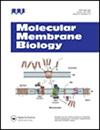Solid-state NMR structures of integral membrane proteins
Q3 Biochemistry, Genetics and Molecular Biology
引用次数: 15
Abstract
Abstract Solid-state NMR is unique for its ability to obtain three-dimensional structures and to measure atomic-resolution structural and dynamic information for membrane proteins in native lipid bilayers. An increasing number and complexity of integral membrane protein structures have been determined by solid-state NMR using two main methods. Oriented sample solid-state NMR uses macroscopically aligned lipid bilayers to obtain orientational restraints that define secondary structure and global fold of embedded peptides and proteins and their orientation and topology in lipid bilayers. Magic angle spinning (MAS) solid-state NMR uses unoriented rapidly spinning samples to obtain distance and torsion angle restraints that define tertiary structure and helix packing arrangements. Details of all current protein structures are described, highlighting developments in experimental strategy and other technological advancements. Some structures originate from combining solid- and solution-state NMR information and some have used solid-state NMR to refine X-ray crystal structures. Solid-state NMR has also validated the structures of proteins determined in different membrane mimetics by solution-state NMR and X-ray crystallography and is therefore complementary to other structural biology techniques. By continuing efforts in identifying membrane protein targets and developing expression, isotope labelling and sample preparation strategies, probe technology, NMR experiments, calculation and modelling methods and combination with other techniques, it should be feasible to determine the structures of many more membrane proteins of biological and biomedical importance using solid-state NMR. This will provide three-dimensional structures and atomic-resolution structural information for characterising ligand and drug interactions, dynamics and molecular mechanisms of membrane proteins under physiological lipid bilayer conditions.整体膜蛋白的固态核磁共振结构
固态核磁共振是独特的,因为它能够获得三维结构和测量天然脂质双层膜蛋白的原子分辨率结构和动态信息。固体核磁共振测定整体膜蛋白结构的数量和复杂性日益增加,主要有两种方法。定向样品固态核磁共振使用宏观排列的脂质双分子层来获得定向约束,这些定向约束定义了嵌入肽和蛋白质的二级结构和全局折叠,以及它们在脂质双分子层中的取向和拓扑结构。魔角旋转(MAS)固态核磁共振使用无取向的快速旋转样品来获得定义三级结构和螺旋排列的距离和扭转角约束。描述了所有当前蛋白质结构的细节,突出了实验策略和其他技术进步的发展。有些结构源于固体和溶液态核磁共振信息的结合,有些则使用固体核磁共振来改进x射线晶体结构。固态核磁共振也通过溶液态核磁共振和x射线晶体学验证了不同膜模拟物中蛋白质的结构,因此与其他结构生物学技术是互补的。通过对膜蛋白靶点的识别和表达、同位素标记和样品制备策略、探针技术、核磁共振实验、计算和建模方法的不断努力,以及与其他技术的结合,利用固态核磁共振确定更多具有生物学和生物医学重要性的膜蛋白的结构应该是可行的。这将为表征配体和药物相互作用、生理脂质双分子层条件下膜蛋白的动力学和分子机制提供三维结构和原子分辨率结构信息。
本文章由计算机程序翻译,如有差异,请以英文原文为准。
求助全文
约1分钟内获得全文
求助全文
来源期刊

Molecular Membrane Biology
生物-生化与分子生物学
CiteScore
4.80
自引率
0.00%
发文量
0
审稿时长
>12 weeks
期刊介绍:
Cessation.
Molecular Membrane Biology provides a forum for high quality research that serves to advance knowledge in molecular aspects of biological membrane structure and function. The journal welcomes submissions of original research papers and reviews in the following areas:
• Membrane receptors and signalling
• Membrane transporters, pores and channels
• Synthesis and structure of membrane proteins
• Membrane translocation and targeting
• Lipid organisation and asymmetry
• Model membranes
• Membrane trafficking
• Cytoskeletal and extracellular membrane interactions
• Cell adhesion and intercellular interactions
• Molecular dynamics and molecular modelling of membranes.
• Antimicrobial peptides.
 求助内容:
求助内容: 应助结果提醒方式:
应助结果提醒方式:


